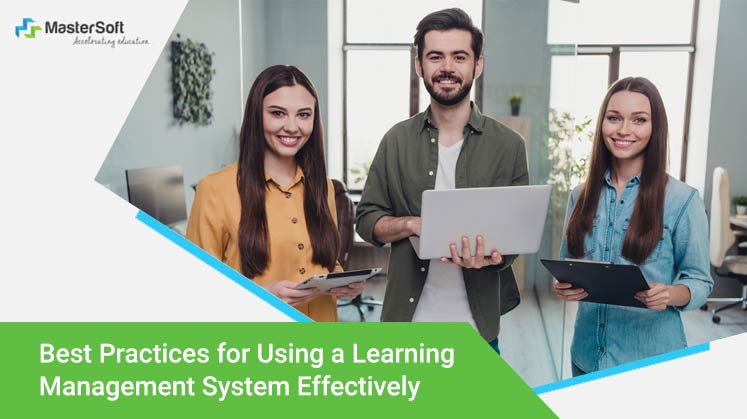The learning management system is an ERP solution that helps institutes to manage teaching-learning operations with high efficiency and accuracy. The system is easy to use and based on a cloud platform for safe storage and backup options.
However, many institutes are new to working with the ERP solution and find it difficult to use it with its maximum capacity and enhance their management. Hence, here are a few practices that will help you to use the learning management system effectively.
Create Complete Awareness-
The institute must create complete awareness regarding the usage of the learning management system. The vendors must provide rigorous training to the teachers and students of the institute regarding the usage of all features and aspects of the learning management system.
The software is built in sync with the traditional working of institutes. Hence, all the work and tasks are conducted in the system, in the same way as previous processes. But to understand the similarities and work with the same workflow, the users should be well-versed with the system, its usage, problems, and how it can be integrated with the other devices and ERP solutions for improved functioning and ease of use. Moreover, making users aware of the importance of security and how to secure their accounts and data is also important for a safe institute’s functioning.
Set Goals-
The institutes must set goals with the working of the learning management system in terms of teaching-learning, student learning outcomes, and other factors. The faculty can help the teachers to understand that they can conduct data analysis operations to get insights about students’ performance, weaknesses, strong subjects of individuals, most effective methods of teaching, and the places that have scope for change.
Goal setting allows the teachers and students to move further in their ways and push boundaries. It enhances the ways of teaching-learning and improves student’s learning outcomes
Integration with other software-
The learning management system can be integrated with other systems and devices for the improved workflow of all processes and activities. It reduces the need for human intervention and conducts all monotonous and tedious tasks with high accuracy and efficiency. It enhances the method of conducting all operations.
It ensures efficient usage of the software and reduces faculty workload. Moreover, all tasks are carried out with great ease in the institute.
Mobile/Laptop Access-
The learning management system should be accessible to the students and teachers on laptops, mobile phones, tablets, or any other device at their convenience. This makes it easy for the students and parents to access the system, check notifications, get information, or upload and download any data whenever required.
It enhances the ways of conducting operations by offering maximum accessibility of data and resources whenever required by students and teachers.
Take Feedback-
The institutes must take feedback from teachers and students to understand the working of the software. The feedback must ask questions about their experience with the ERP solution, things that can be made better, and problems faced by them in the system.
It will help the institute to improve the user experience with the software and enhance student learning outcomes in the long run.
Make Clear Expectations-
The institutes need to specify what is expected from the teachers and students concerning the learning management system. The software helps institutes to enhance their operations and conduct them through smart solutions.
When the students and teachers know what is expected from them, they can set on a clear path of moving forward with their goals and ambitions.
Enables E-Learning-
The online method of education makes use of a learning management system to manage and track all student activities and store the data. The introduction of LMS software has increased the adoption of e-learning courses and distance learning programs across institutes.
Further, the introduction of NEP 2020 has given a major emphasis on the implementation of a multi-disciplinary approach. It allows the students to study different courses from different institutes. This is possible only if the institutes offer e-learning courses. It enhances the student’s experience with learning. It allows them to study courses of their choice in any area and field even apart from their core subjects. They can fulfill their hobbies and explore new interests.
Lecture Recording-
The LMS software enables the teachers to record all the online lectures delivered to the students. If any student misses the lectures can get a lecture recording of the topic and subject and would not be left on anything that is taught by the teacher. This ensures everyone is receiving the lectures, notes, study materials, and other information given in the lectures.
New Learning Methods-
The LMS software enables teachers to implement new ways of teaching using videos, animations, storytelling, gamification, interactive sessions, discussions, and others. It also enables students to conduct debates and work together on group projects and assignments even in an online setting. This ensures that the students do not miss out on anything even if they are located remotely from each other. They can share their knowledge and work together.
Online Examination-
The Learning management system allows the institutes to conduct examinations online. It enables the institute to offer certificates and degrees to the students based on their performance in the examination. Students can attempt exams remotely from any location just by using a laptop/mobile and internet connection. The system functions even on the low bandwidth of the internet.
These exams are highly secure and they use anti-cheating technology to ensure that exams are conducted safely. It helps to maintain the integrity of the institute. The LMS software conducts run-time monitoring of students during the exam and takes frequent screenshots of their activities.
Easy Data Management-
The learning management system receives loads of student data from various sources such as attendance management, examination, student performance, fee collection, admission information, and others. This data is to be kept safe and secure such that it is easy to search and retrieve, any required information across the stored information. It enhances the data storage methods and increases its efficiency. There is no risk of data redundancy or any gaps. It is stored in a centralized manner which allows easy access to the authorized faculty members.
Conclusion-
The learning management system is a robust solution that enables the institute to enhance their institute’s teaching-learning and improve students’ learning outcomes. The software also enables teachers to use different methods of learning to engage students and increase their interest in learning. The software is easy to use and highly secure.
Tips & Tricks To Choose The Best Assignment Help Service – ZoomBazi





